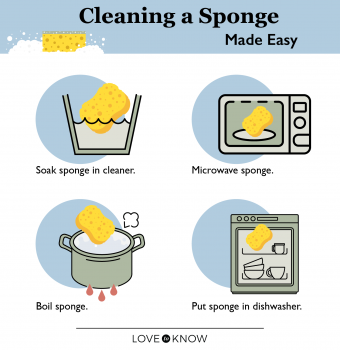
Does your sponge need a little TLC? To get the most out of your cleaning adventure, you might want to consider sanitizing your sponge after using it. Cleaning sponges is pretty easy if you have the right tools. Learn a few easy methods to zap those germs for good.
Getting Rid of Bacteria in a Sponge
According to a study done in 2017, sponges carry a lot of bacteria. When you are using them to wipe down your counters where your food goes, that fact doesn't give you the warm fuzzies. Therefore, it's important to make sure to clean your sponges after you use them. And wringing them out to let them air dry isn't enough. But, there are a few methods you can try with minimal materials.
- White vinegar
- Peroxide
- Bleach
- Microwave
- Saucepan
- Dishwasher
- Tongs

How to Clean Sponge With White Vinegar
A great natural way to clean your sponge is to reach for the white vinegar. The natural acid works well to get rid of most of the germs in your house that would make you sick. To clean a sponge with vinegar is easy.
- Fill a bowl with straight white vinegar.
- Put your sponge in the bowl.
- Allow it to soak for 5-10 minutes.
- Flip and repeat the soak.
- Rinse and wring out well before putting away.
Disinfect Sponge in Boiling Water
Don't have any white vinegar on hand? Not to worry. Just boil up a bit of hot water.
- Boil enough water to cover the sponge completely.
- Turn the water off.
- Throw the sponge in and let it sit for 5 minutes.
- Grab it out with tongs.
- Rinse with cold water.
How to Disinfect Sponge in Microwave
If you don't want to wait around to boil water, then the microwave is your next best option. Actually, sanitizing with the microwave is a great way to disinfect sponges after each use.
- Put a wet sponge in the microwave for 1 minute.
- Allow it to cool for 10 or so minutes.
- Pull it out and wring out any remaining water.
- Put it away.
Cleaning Sponge in the Dishwasher
If you are doing a load of dishes in the dishwasher, you can throw your sponge in to get it sanitized.
- Rinse out the sponge.
- Put it on the top rack in the dishwasher.
- Put the dishwasher on the longest hottest setting.
- You can also just throw it in the dishwasher for the drying cycle to get rid of bacteria.
Other Ways to Get Sponges Clean
While these are a few of the go-to methods for people looking for a natural cleaning method, you can also use a few chemicals like bleach and peroxide to clean your sponge.
Bleach Method
Bleach is very effective at killing germs, but it's a harsh chemical, so be cautious when using it.
- Soak the sponge for a minute or two in a mixture of 1 teaspoon of bleach to a cup of water.
- Rinse and wring out completely.
Peroxide Method
Worried about using bleach in your home? Try cleaning your sponge with a bit of peroxide.
- You can also soak the sponge for a minute or two in a bowl of hydrogen peroxide.
- Rinse your sponge and wring it out.
While these are both chemicals, they are sure to clean most of the germs from your sponges in no time flat.
How Often to Replace Sponge
While these methods are going to get rid of a good portion of the bacteria in your sponges, they aren't going to get rid of it all. Sponges are very porous and getting rid of all those germs 100% is impossible. Therefore, you should replace your sponge every few weeks or if it starts to smell or look tattered. Some actually recommend placing it after every use. This ensures that you aren't going to just be moving the bacteria around as you clean.
Getting Your Sponge Clean
When it comes to cleaning up messes in your kitchen and bathroom, a sponge is a go-to. However, they get surprisingly full of germs after a while. So, it's important to make sure you clean your sponge regularly and replace it every few weeks or if it gets dirty.







